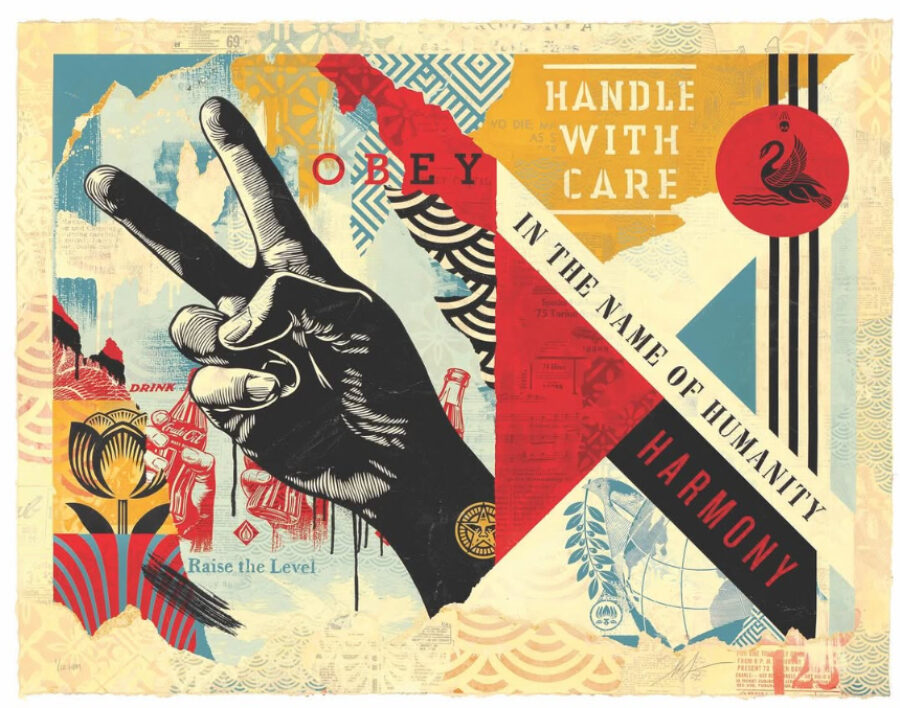In an era of climate change, social inequality, war, and humanitarian crises, politically engaged art has become more than a form of expression; it is a tool for activism. Artists worldwide are leveraging their creative platforms to expose injustice, spark debate, and inspire collective action. The line between art and activism continues to blur as creative works become powerful vehicles for sociopolitical messaging.
Shepard Fairey: The Visual Voice of Protest
The Art of Social Awakening
One of the most influential figures in political art is Shepard Fairey, whose striking visual style combines bold typography, propaganda aesthetics, and socially charged messages. His works function as both art and political commentary, drawing attention to themes of power, peace, and justice.
A defining example of his work features a stylized hand forming the peace sign, framed by slogans such as “OBEY,” “Handle with Care,” and “Harmony.” This composition underscores humanity’s responsibility for social harmony and the fragility of peace. Fairey’s art is designed to provoke thought, urging viewers to question authority and engage in meaningful discourse.
From Street Art to Global Activism
Born in 1970 in Charleston, South Carolina, Fairey gained recognition in the early 1990s with his “OBEY” campaign, a movement that redefined street art as a medium for social commentary. His global breakthrough came in 2008 with the iconic “HOPE” poster for Barack Obama’s presidential campaign, a symbol of optimism and progressive change.
Beyond his fine art, Fairey expands his activism through large-scale murals, poster campaigns, and his influential Obey Clothing brand, which integrates social critique into fashion. His works, which address themes of consumerism, environmentalism, and human rights, are housed in renowned institutions such as the Museum of Modern Art in New York. Fairey’s career illustrates how politically engaged art can shape public consciousness and influence global movements.
Art as a Reflection of Global Crises
Fairey is not alone in using art as a response to global challenges. Visionary artists like Olafur Eliasson create immersive experiences that translate abstract crises into tangible realities. His installation Ice Watch (2014-2019) brought massive, melting ice blocks from Greenland to city centers, allowing the public to witness the effects of climate change firsthand.
Participatory art is also gaining traction as a tool for sociopolitical engagement. Tania Bruguera’s Tatlin’s Whisper #6, which invited Cubans to publicly voice their opinions under the protection of free speech for one minute, and the American activist collective Not An Alternative demonstrate how artistic interventions can expose systemic injustices and ignite public discourse. These “artivists”, a fusion of artists and activists, do not merely document issues but actively challenge and reshape them.
The Power and Limitations of Political Art
Can art drive real societal change? Political art has the power to evoke emotions, challenge perspectives, and unify communities. However, for substantial transformation to occur, art must be complemented by political, economic, and social action.
For example, the Guerrilla Girls have used provocative and satirical interventions to expose gender disparities in the art world. Their impact extends beyond galleries, influencing institutional policies and shifting industry standards. This underscores a crucial reality: while political art can inspire change, its true potential is unlocked when combined with activism and civic engagement.
Why Political Art Matters More Than Ever
As global crises intensify, art remains an essential medium for political expression. Artists like Shepard Fairey and Olafur Eliasson continue to challenge societal norms, using their creative platforms to amplify urgent issues and drive conversations that lead to action.
The real question is: Are we willing to let art challenge our perceptions? Will we move beyond passive appreciation and transform artistic inspiration into tangible change? The power of political art lies not just in its visual impact but in its ability to stir minds and spark action.
Take Action: Support Artists Driving Social Change
Engage with political art by supporting artists, attending exhibitions, and sharing their work. Join conversations, advocate for change, and let creativity fuel your activism.









